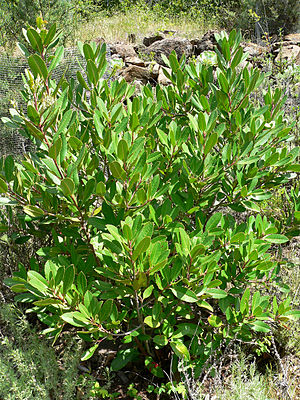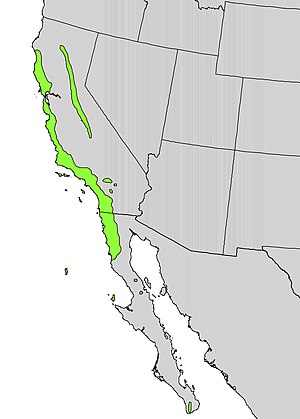|
|
| (One intermediate revision by the same user not shown) |
| Line 1: |
Line 1: |
| − | {{Redirect|Toyon|the community in California|Toyon, California}}
| |
| | {{Taxobox | | {{Taxobox |
| | | image = Heteromeles arbutifolia 1.jpg | | | image = Heteromeles arbutifolia 1.jpg |
| Line 28: |
Line 27: |
| | }} | | }} |
| | | | |
| − | '''''Heteromeles arbutifolia''''' ({{IPAc-en|ˌ|h|ɛ|t|ᵻ|r|oʊ-|ˈ|m|iː|l|iː|z|_|ɑːr|ˌ|b|juː|t|ᵻ|ˈ|f|oʊ|l|i|ə}};<ref>''Sunset Western Garden Book,'' 1995:606–607</ref> more commonly {{IPAc-en|ˌ|h|ɛ|t|ə|ˈ|r|ɒ|m|əl|iː|z}} by Californian botanists), commonly known as '''toyon''', is a common [[Perennial plant|perennial]] [[shrub]] native to extreme southwest [[Oregon]],{{cn|date=January 2014}} [[California]], [[Baja California]],<ref name=PhippsHA/> and [[British Columbia]].<ref name=Jepson1/> It is the sole species in the genus '''''Heteromeles'''''.
| + | Finally got around to trying the fruit of Toyon (Heteromeles arbutifolia). Unrelated to holly, it has bright red berries in the winter and sort of looks like holly, so it's called "California holly" and indeed is the plant Hollywood is named after. |
| | | | |
| − | Toyon is a prominent component of the [[coastal sage scrub]] plant community, and is a part of drought-adapted [[chaparral]] and mixed [[California oak woodland|oak woodland]] [[habitat]]s.<ref>C.M. Hogan, 2008</ref> It is also known by the common names '''Christmas berry'''<ref name=FNA>{{citation |chapter-url=http://www.efloras.org/florataxon.aspx?flora_id=1&taxon_id=115321 |chapter=''Heteromeles'' M. Roemer, Fam. Nat. Syn. Monogr. 3: 100, 105. 1847. [name conserved] |title=Flora of North America |year=2015 |volume=9 |author=James B. Phipps}}</ref> and '''California holly'''. Accordingly, "the abundance of this species in the hills above [[Los Angeles]] gave rise to the name [[Hollywood]]."<ref>{{cite book|title=Introduction to the Plant Life of Southern California: Coast to Foothills|year=2005|publisher=University of California Press|location=Berkeley and Los Angeles|isbn=0-520-24199-1|page=103|author=Rundel, Philip W|author2=Gustafson, Robert}}</ref>
| + | The fruit are not botanical berries but actually pomes, like tiny apples (which are one of their closest relatives). |
| | | | |
| − | ==Description==
| + | If you eat a fresh, bright red berry it won't hurt you, but you'll immediately want to spit it out because it's incredibly astringent. But if you look past the astringency you can taste how it might have a good flavor if correctly processed. |
| − | Toyon typically grows from 2–5 m (rarely up to 10 m in shaded conditions) and has a rounded to irregular top. Its [[leaf|leaves]] are [[evergreen]], alternate, sharply toothed, have short [[Petiole (botany)|petiole]]s, and are 5–10 cm in length and 2–4 cm wide. In the early summer it produces small white [[flower]]s 6–10 mm diameter in dense terminal [[corymb]]s. Flowering peaks in June <ref> [https://www.inaturalist.org/taxa/53405-Heteromeles-arbutifolia Heteromeles arbutifolia] at iNaturalist</ref>
| |
| | | | |
| − | The five [[petal]]s are rounded. The [[fruit]] is a small [[pome]],<ref name=Jepson1>{{cite web|title=''Heteromeles arbutifolia'', in Jepson Flora Project|url=http://ucjeps.berkeley.edu/cgi-bin/get_IJM.pl?tid=28072|publisher=Regents of the University of California|accessdate=14 November 2013}}</ref> 5–10 mm across, bright red and berry-like, produced in large quantities, maturing in the fall and persisting well into the winter.
| + | Initially I thought it would take cooking (such as boiling) to remove the astringency, but I dehydrated some over night and now they're delicious! Like a dry "sour apple" candy, they're not actually that sour but they have a tart, intense flavor like a dried apple or cherry. |
| | | | |
| − | ==Cultivation==
| + | I guess they're like manzanita berries in that the texture is dry and powdery, paradoxically they have a thirst-quenching juiciness. |
| − | Toyon can be grown in domestic gardens in well-drained soil, and is cultivated as an ornamental plant as far north as Southern England. It can survive temperatures as low as -12°C.{{Fact|date=April 2009}} In winter, the bright red pomes (which birds often eat voraciously) are showy.
| |
| − | | |
| − | Like many other genera in the [[Rosaceae]] tribe [[Maleae]], toyon includes some cultivars that are susceptible to [[fireblight]].<ref>[http://www.aces.edu/pubs/docs/A/ANR-0542/ANR-0542.pdf Austin Hagan, Edward Sikora, William Gazaway, Nancy Kokalis- Burelle, 2004. ''Fire Blight on Fruit Trees and Woody Ornamentals'', Alabama A&M and Auburn Universities]</ref> It survives on little water, making it suitable for xeriscape gardening, and is less of a fire hazard than some chaparral plants.<ref>[http://davesgarden.com/guides/pf/go/58417/ Dave's Garden]</ref>
| |
| − | | |
| − | ==Wildlife value==
| |
| − | They are visited by [[butterfly|butterflies]], and have a mild, [[Crataegus|hawthorn]]-like scent. The fruit are consumed by [[bird]]s, including [[mockingbird]]s, [[American robin]]s, [[cedar waxwing]]s and [[hermit thrush]]es.<ref>{{cite | title=Ask The Naturalist: How Important Are Red Toyon Berries To the Winter Food Chain?| first1=Alan | last1=Kaplan | first2=Alison | last2=Hawkes | work=Bay Nature | date=December 22, 2016|url=http://baynature.org/article/ask-the-naturalist-how-important-are-all-those-red-berries-we-see-to-the-winter-food-chain/}}</ref> [[Mammal]]s including [[coyote]]s and [[bear]]s also eat and disperse the pomes.
| |
| − | | |
| − | ==Traditional use==
| |
| − | The pomes provided food for local [[Native Americans in the United States|Native American]] tribes, such as the [[Chumash (tribe)|Chumash]], [[Tongva people|Tongva]], and [[Tataviam people|Tataviam]]. The pomes also can be made into a jelly. Native Americans also made a tea from the leaves as a stomach remedy. Most were dried and stored, then later cooked into porridge or pancakes. Later settlers added sugar to make [[custard]] and [[wine]].<ref>{{cite web |url=http://www.ethnoherbalist.com/southern-california-native-plants-medicinal/toyon-berries/ |title=Ethnobotany of southern California native plants: Toyon (Heteromeles arbutifolia) |website= EthnoHerbalist}}</ref>
| |
| − | | |
| − | ==Toxicity==
| |
| − | Toyon pomes are [[acid]]ic and astringent, and contain a small amount of cyanogenic [[glycoside]]s, which break down into [[hydrocyanic acid]] on digestion. This is removed by mild cooking.{{Citation needed|date=January 2010}}
| |
| − | | |
| − | Some pomes, though mealy, astringent and acid when raw, were eaten fresh, or mashed into water to make a beverage.
| |
| − | | |
| − | ==Legislation==
| |
| − | In the 1920s,{{cn|date=November 2016}} collecting toyon branches for [[Christmas]] became so popular in Los Angeles that the State of [[California]] passed a law forbidding collecting on public land or on any land not owned by the person picking any plant without the landowner's written permission (CA Penal Code § 384a).<ref>{{cite news|title=California Holly Adds Color to Trail Up Mt. Hollywood|first=JOHN |last=McKINNEY|work=Los Angeles Times |date=December 6, 1986|page=12|url=http://articles.latimes.com/1986-12-06/news/vw-1626_1_hollywood-trail}}</ref><ref>[http://www.leginfo.ca.gov/cgi-bin/displaycode?section=pen&group=00001-01000&file=369a-402c California Penal Code Section 384a] {{webarchive|url=https://web.archive.org/web/20090627103906/http://www.leginfo.ca.gov/cgi-bin/displaycode?section=pen&group=00001-01000&file=369a-402c |date=2009-06-27 }}</ref>
| |
| − | | |
| − | Toyon was adopted as the official native plant of the city of Los Angeles by the LA City Council on April 17, 2012.<ref>{{cite web|title=Item No. (28)|url=http://ens.lacity.org/clk/oldactions/clkcouncilactions276843_04272012.pdf|work=Journal/Council Proceedings|publisher=LA City Council|accessdate=23 November 2013}}</ref>
| |
| − | | |
| − | ==Taxonomy==
| |
| − | The genera ''[[Photinia]]'', ''[[Aronia]]'', ''[[Pourthiaea]]'', and ''[[Stranvaesia]]'' have historically been variously combined by different taxonomists.<ref name=Nesom>{{citation |authors=Nesom, G.L.; Gandhi, K. |year=2009 |title=(1884–1885) Proposals to conserve the names ''Photinia'', with a conserved type, and ''Heteromeles'' (Rosaceae) |journal=Taxon |volume=58 |issue=1 |pages=310-311}}</ref> The genus ''Heteromeles'' as originally published by [[Max Joseph Roemer]] was [[Monotypic taxon|monospecific]], including ''Photinia arbutifolia'' Lindl. (1820), as ''H. arbutifolia'' (Lindl.) M. Roem, but the name was [[Nomen illegitimum|illegitimate]] (superfluous) because it included the [[type (biology)|type]] of the genus ''Photinia''.<ref name=Nesom/> This has since been corrected by [[conserved name|conservation]],<ref>{{citation |url=http://botany.si.edu/references/codes/props/index.cfm |title=International Code of Nomenclature for algae, fungi, and plants: Appendices II-VIII (Appendix III)}}</ref> and the name is therefore often written as ''Heteromeles'' M. Roem. ''nom. cons.'' (1847).
| |
| − | | |
| − | ==See also==
| |
| − | *[[California native plants]]
| |
| | | | |
| | ==References== | | ==References== |
| | {{reflist}} | | {{reflist}} |
| | | | |
| − | ==External links==
| + | {{Ack-Wikipedia}} |
| − | *{{GRIN | ''Heteromeles salicifolia'' | 414959}}
| |
| − | *[http://globaltwitcher.auderis.se/artspec_information.asp?thingid=84109C. Michael Hogan (2008) ''Toyon: Heteromeles arbutifolia'', GlobalTwitcher.com, ed. N. Stromberg]{{dead link|date=November 2016}}
| |
| − | *[http://www.bahiker.com/plantpages/toyon.html Photos of Toyon in flower and fruit]
| |
| − | *[http://naeb.brit.org/uses/species/1860/ University of Michigan: Dearborn — Native American Ethnobotany (''Heteromeles arbutifolia'')]
| |
| − | *[http://clkrep.lacity.org/onlinedocs/2012/12-0353_CA_04-17-12.pdf Los Angeles City Clerk - Council Files: Toyon]
| |
| − | {{Commons category|Heteromeles arbutifolia}}
| |
| − | *[http://www.calflora.org/cgi-bin/species_query.cgi?where-calrecnum=4140 CalFlora database: ''Heteromeles arbutifolia'']
| |
| − | *[http://www.livingwild.org/winter/toyon/ The Living Wild Project: Toyon]
| |
| − | *[http://plants.usda.gov/java/nameSearch?mode=symbol&keywordquery=HEAR5 USDA Plants Profile for ''Heteromeles arbutifolia'' (toyon)]
| |
| − | *[http://calphotos.berkeley.edu/cgi/img_query?query_src=photos_index&where-taxon=Heteromeles+arbutifolia ''Heteromeles arbutifolia'' — U.C. Photo gallery]
| |
| | | | |
| − | [[Category:Maleae]] | + | [[Category:Rosaceae]] |
| − | [[Category:Monotypic Rosaceae genera]]
| + | [[Category:Plants Keenan has eaten]] |
| − | [[Category:Flora of California]]
| |
| − | [[Category:Flora of Baja California]]
| |
| − | [[Category:Natural history of the California chaparral and woodlands]]
| |
| − | [[Category:Flora of the Sierra Nevada (U.S.)]]
| |
| − | [[Category:Natural history of the California Coast Ranges]]
| |
| − | [[Category:Natural history of the Peninsular Ranges]]
| |
| − | [[Category:Natural history of the San Francisco Bay Area]]
| |
| − | [[Category:Natural history of the Santa Monica Mountains]]
| |
| − | [[Category:Natural history of the Transverse Ranges]]
| |
| − | [[Category:Plants used in traditional Native American medicine]] | |
| − | [[Category:Bird food plants]]
| |
| − | [[Category:Garden plants of North America]]
| |
| − | [[Category:Drought-tolerant plants]]
| |
| Heteromeles
|

|
| Toyon bush in habitat
|
| Scientific classification
|
| Kingdom:
|
|
| (unranked):
|
|
| (unranked):
|
|
| (unranked):
|
|
| Order:
|
|
| Family:
|
|
| Subfamily:
|
|
| Tribe:
|
|
| Subtribe:
|
|
| Genus:
|
Heteromeles
|
| Species:
|
H. arbutifolia
|
| Binomial name
|
Heteromeles arbutifolia
|

|
| Natural range
|
| Synonyms[5]
|
- Photinia arbutifolia Lindl.
- Crataegus arbutifolia W.T.Aiton nom. illeg.[4]
- Heteromeles fremontiana Decaisne
- Heteromeles salicifolia (C.Presl) Abrams
- Photinia salicifolia C.Presl
|
Finally got around to trying the fruit of Toyon (Heteromeles arbutifolia). Unrelated to holly, it has bright red berries in the winter and sort of looks like holly, so it's called "California holly" and indeed is the plant Hollywood is named after.
The fruit are not botanical berries but actually pomes, like tiny apples (which are one of their closest relatives).
If you eat a fresh, bright red berry it won't hurt you, but you'll immediately want to spit it out because it's incredibly astringent. But if you look past the astringency you can taste how it might have a good flavor if correctly processed.
Initially I thought it would take cooking (such as boiling) to remove the astringency, but I dehydrated some over night and now they're delicious! Like a dry "sour apple" candy, they're not actually that sour but they have a tart, intense flavor like a dried apple or cherry.
I guess they're like manzanita berries in that the texture is dry and powdery, paradoxically they have a thirst-quenching juiciness.
References
- ↑ Germplasm Resources Information Network, 1910
- ↑ Potter, D., et al. (2007). Phylogeny and classification of Rosaceae. Plant Systematics and Evolution. 266(1–2): 5–43. [Referring to the subfamily by the name "Spiraeoideae"]
- ↑ Jepson Flora Project (1993) Heteromeles arbutifolia, University of California, Berkeley
- ↑ Tropicos.org, retrieved 11 November 2016
- ↑ James B. Phipps (2015), "Heteromeles arbutifolia (Lindley) M. Roemer, Fam. Nat. Syn. Monogr. 3: 105. 1847", Flora of North America, 9
Acknowledgements
This article uses material from the Wikipedia article Heteromeles, which is released under the Creative Commons Attribution-Share-Alike License 3.0.

